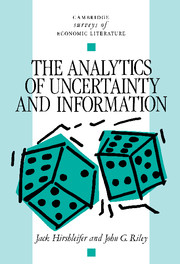Book contents
- Frontmatter
- Contents
- Acknowledgments
- Introduction: The economics of uncertainty and information
- Part I
- Part II
- 5 Information and informational decisions
- 6 The economics of emergent public information
- 7 Research and invention
- 8 Informational asymmetry and contract design
- 9 Strategic uncertainty and equilibrium concepts
- 10 The economics of contests
- 11 Competition and hidden knowledge
- 12 Long-run relationships and the credibility of threats and promises
- Index
12 - Long-run relationships and the credibility of threats and promises
Published online by Cambridge University Press: 05 June 2012
- Frontmatter
- Contents
- Acknowledgments
- Introduction: The economics of uncertainty and information
- Part I
- Part II
- 5 Information and informational decisions
- 6 The economics of emergent public information
- 7 Research and invention
- 8 Informational asymmetry and contract design
- 9 Strategic uncertainty and equilibrium concepts
- 10 The economics of contests
- 11 Competition and hidden knowledge
- 12 Long-run relationships and the credibility of threats and promises
- Index
Summary
The previous chapter showed that individuals may be willing to undertake otherwise wasteful “signaling” activities in order to make favorable information about themselves credible to other parties. However, that analysis presumed a one-time interaction among players. This chapter inquires into the further information transmission opportunities that are introduced when individuals interact with one another repeatedly.
In some cases at least, an individual should be able to make favorable information about himself (information that he is a high-quality or otherwise desirable trading partner) credible by actions taken in the early periods of a long-run relationship. That is, an individual should be able to develop a reputation. As we shall see, however, reputation-building may be unprofitable even when the distant future is only very mildly discounted.
The multi-period Prisoners' Dilemma
Let us begin by examining the Prisoners' Dilemma. In table 12.1 below, each individual i (i = 1,2) may choose to play either “Defect” (strategy x1) or “Cooperate” (strategy x2). The Prisoners' Dilemma environment is defined by the ranked payoffs in table 12.1 if e > f > g > h. Table 12.2 is a numerical example.
When the Prisoners' Dilemma is played just once, it is evident that the Defect strategy x1 is strictly dominant for each player. The unique Nash equilibrium is therefore for both individuals to choose x1. In the illustrative example of table 12.2, each player's payoff would be zero.
- Type
- Chapter
- Information
- The Analytics of Uncertainty and Information , pp. 431 - 457Publisher: Cambridge University PressPrint publication year: 1992



